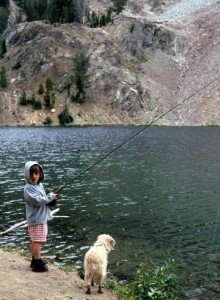Adventure Fishing / Central Idaho
Online Alpine Fishing Guide / Where and How to Catch an Alpine Fish
Over the past 40 years, I’ve explored more than 1,200 lakes and streams across the remote corners of Central Idaho, immersing myself in its rich fishing heritage. My work has appeared in over 25 respected fishing publications, and when it comes to understanding the region’s angling terrain—few, if any, know it better.
As Meriwether Lewis—Thomas Jefferson’s gifted private secretary—and his trusted co-leader William Clark approached the western edge of what is now the Montana-Idaho border, their expedition was halted by a formidable barricade of towering, snow-laden peaks. This impassable wall of mountains forced a sudden redirection of their westward quest toward the Pacific. In search of a navigable route, the explorers traversed the Beaverhead Range, crossing from Montana into Lemhi Pass, and became the first white men to step into the easternmost reaches of central Idaho. Yet their hopes were once again dashed by an even more daunting range—its commanding summits multiplying into a vast, jagged sea of white-capped ridges stretching endlessly westward, as if the very horizon had been swallowed by stone and snow.
Upon hearing of a river—the Salmon—said by Native tribes to have carved a passage through the forbidding maze of peaks, Lewis and Clark pinned their hopes on navigating its untested waters westward through what is now Central Idaho. But after a brief survey of its violent rapids and sheer canyon walls, Lewis deemed the river impassable and turned back in search of an alternate route to the Pacific. What Jefferson’s famed explorers encountered in 1804 was the largest continuous mountain wilderness in the continental United States—a vast, roadless expanse second only to Alaska in scale. Today, Central Idaho’s highlands, sprawling across an area larger than Switzerland, remain a formidable wilderness of glacial cirque lakes and trout-filled mountain streams—still as raw, remote, and humbling as the day they turned back America’s first pathfinders.
🎣 Fishing Tips for Idaho’s Alpine Empire
Fishing the high mountain lakes and streams of Central Idaho requires a thoughtful approach. These alpine waters often struggle to naturally sustain robust trout populations due to limited spawning tributaries. However, one notable exception is the Brook Trout. Brookies are prolific breeders, capable of spawning in oxygen-poor environments, and are rarely restocked by Idaho Fish and Game—making them a self-sustaining species in many upland areas.
Before casting your line, take a moment to observe the fish. If you notice an abundance of small trout with disproportionately large heads, it’s a sign the population has outgrown its food supply. In such cases, keeping a few fish can help ease overcrowding and improve overall health.
Conversely, if you encounter a small number of larger fish—typically rainbows, goldens, or cutthroats—and see little evidence of spawning flows, it likely means the population relies on human stocking. In these fragile ecosystems, harvesting fish can have serious consequences. Practicing responsible catch-and-release is essential.
✅ Use barbless hooks
✅ Avoid removing fish from the water
✅ Minimize handling—always wet your hands first
❌ Never touch a fish with dry hands
These simple steps help preserve the wild character of Idaho’s alpine fisheries. If you’re looking for advice on where to go or how to catch trout in Central Idaho, feel free to drop me a note—I’d be happy to help.
Link to Sun Valley Idaho Flyfishing Adventures
Questions: Contact Me?
{This email is obscured. Your must have javascript enabled to see it}
Contact Form

